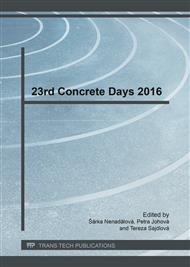[1]
S. Xu, H.W. Reinhardt, Determination of double-K criterion for crack propagation in quasi-brittle fracture, Part II: Analytical evaluation and practical measuring methods for three-point bending notched beams, Int. Journal of Fracture, 98 (1999).
Google Scholar
[2]
S. Kumar, S. V. Barai, Concrete Fracture Models and Applications, Springer, Berlin, (2011).
Google Scholar
[3]
C. U. Grosse, M. Ohtsu, Acoustic Emission Testing: Basics for Research – Applications in Civil Engineering; with contributions by numerous experts, Springer, Heidelberg, (2008).
Google Scholar
[4]
M. Ohtsu M. The history and development of acoustic emission in concrete engineering, Magazine of Concrete Research, 48 (1996), 321−330.
DOI: 10.1680/macr.1996.48.177.321
Google Scholar
[5]
H. Šimonová, P. Daněk, D. Lehký, Z. Keršner, L. Pazdera, Evaluation of Three-point Bending Fracture Tests of Selected Concrete: Mechanical Fracture Parameters, printed in this issue.
DOI: 10.4028/www.scientific.net/ssp.259.64
Google Scholar
[6]
X. Zhang, S. Xu, A comparative study on five approaches to evaluate double-K fracture toughness parameters of concrete and size effect analysis, Engineering Fracture Mechanics, 78 (2011) 10, 2115–2138.
DOI: 10.1016/j.engfracmech.2011.03.014
Google Scholar
[7]
P. E. Petersson, Crack growth and development of fracture zone in plain concrete and similar materials, Report No. TVBM-1006, Lund Institute of Technology, (1981).
Google Scholar
[8]
R. V. Sagar: An experimental Study on Acoustic Emission Energy and Fracture Energy of Concrete, Proceedings of the National Seminar & Exhibition on Non-Destructive Evaluation, Tiruchirappalli, India, 2009, 225–228.
Google Scholar
[9]
M. Huang, L. Jiang, P. K. Liaw, C. R. Brooks, R. Seeley, D. L. Klarstrom, Using acoustic emission in fatigue and fracture materials research, JOM-e, 50 (1998) 11.
Google Scholar
[10]
M. Iwanami, T. Kamada, S. Nagataki, Application of acoustic emission technique for crack monitoring in RC beams, JCA Proc. Cement and Concrete, 51 (1997), 192–197.
Google Scholar
[11]
Z. Li, Y. Xi: Application of acoustic emission technique to detection of concrete cracking and rebar corrosion, NDT-CE: Int. Symposium Non-Destructive Testing in Civil Engineering, Berlin, 1995, 613–620.
Google Scholar


